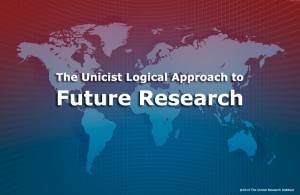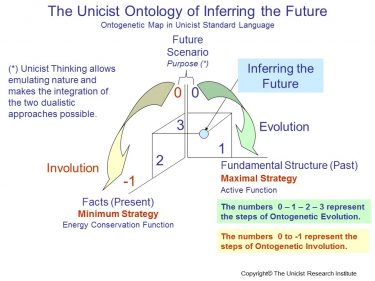The Unicist Approach to Future Research
The unicist approach to future research is based on knowing the nature of an environment that is found in its past and using the data of the present to infer the future based on the knowledge of the evolution laws.
This approach is based on the fact that future and past are not symmetric. This is the case of all the environments that are evolving or involving. The past and the future are only symmetric in stagnated environments.
The Unicist Approach to Future Research is based on the research of the unicist ontogenetic intelligence of nature that started at the beginning of the 80’s. It was developed at The Unicist Research Institute.
It was a step by step discovery based on the apprehension of the nature of social phenomena entering afterwards in the institutional and individual evolution. Its integration with biology and physics was the final stage that was achieved.
The objective of the unicist approach to future research is to define a future scenario in order to adapt and influence it.
When an individual “looks back” at the history, the events that occurred are reasonable, understandable and logical. Therefore when approaching the future what is required is having the “logic” that is evident when analyzing the events of the past.
The building of future scenarios is based on the fact that the structure of the unicist ontology of a specific environment needs to be found in the past and that the facts of the present are used to infer the future.
The unicist approach to future research is based on inferring the future based on the laws of evolution established by the ontogenetic intelligence of nature, which allowed developing the unicist ontology of evolution.
This allows building reliable future scenarios.
The Unicist Ontology of Cultural Evolution
Introduction
The members of a culture that is evolving naturally accept that they might be involving. This concern is what avoids their involution.
The dominant ethics defines the evolution of a culture and defines its attitude towards influencing the environment. A culture is evolving when it has the capacity to adapt to the environment, meaning that it is able to influence it while it is being influenced.
This implies that the dominant cultural segments and the elite of the culture have a spontaneous attitude towards influencing the environment to generate growth.
As the habits of a culture evolve driven by the dominant ethics, an evolutionary culture evolves when the ethics of value adding prevails and the value earning ethics is the energy conservation function of the culture.
The synthesis
The driver of cultural evolution processes is the adaptation of a culture. This adaptation implies that a democratic attitude prevails, providing the necessary consensus to have social cohesion, being driven by a social efficiency, and making the necessary trade offs to maintain an efficient consensus.
The consensus of an evolutionary culture is oriented towards growth, which implies having a proactive attitude in the environment to generate value. Social efficiency means that the system is institutionalized having therefore a minimum level of entropy.
This institutionalization is materialized in the habits and in the myths and fallacious myths installed in a culture.
Trade-offs are implicitly conflicts and generate crises.
On the one hand, they can be evolution conflicts when they happen within the limits of efficiency and the value earning behavior. Or they can be involution conflicts, on the other hand, when the goal of these trade-offs is “buying” consensus.
In this case the culture enters a conjunctural involution which naturally eliminates the leaders that made this trade-offs if the value adding ethics prevails in the institutions.
If this is not the case, and a survivors’ ethics becomes necessary for the institutions, the culture will have entered into an over-adaptive behavior driving the culture towards involution.
The maximal strategy of evolutionary cultures is sustained by their value adding ethics.
This implies that the leaders of the dominant segments have a level of consciousness that allows them to be aware of the social processes and the long term consequences of the decisions that are made.
Social evolution requires participative processes within an authoritative environment that does not require the exertion of power to be efficient.
The catalyst of the evolution of a culture is given by the value earning behavior which includes a conscious value adding process.
This conscious value adding process is what accelerates the processes of the minimum strategy in order to sustain the adaptive behavior and the evolution of a culture.
The minimum strategy is based on a value earning behavior in order to ensure the wellbeing of a society.
The entropy inhibitor of this value earning process is given by the survivor ethics behavior of the members which ensures the wellbeing of the members of the society.
Levels of cultural evolution
The stability of the evolution of a culture depends on the attitudes of the culture. The spontaneous behaviors of the members of a culture are: Work driven behavior, Education driven behavior, Institution driven behavior, Technology driven behavior.
1) Work driven behavior
It is defined by the “purpose of life” of the members of a culture. Work driven cultures are those where pastime activities are only valid if the duties of work have been fulfilled. People feel guilt if they cannot do “their” work.
2) Education driven behavior
It includes a work driven attitude. The role of the members of a society depends on the educational level of its members. In this case, the central role of families, the introduction of the new generation in the society, is ensuring that they an education that allows them to overcome the level of their parents.
3) Institution driven behavior
It includes the education driven attitude. In these societies the behavior of the members is subordinated to the rules of institutions. Institutional behavior prevails over individualistic attitudes.
Freewill has the place established by institutional rules which have been established in a democratic way. The roles of the members are within the limits of the roles of the institutions.
4) Technology driven behavior
It includes the institutions driven attitude. As technology is the driver for growth, this requires that the members of the dominant segments of a culture need to be technology oriented.
This technology orientation implies seeking for new ways to produce more with less. This attitude fosters growth and drives towards permanent changes in order to upgrade the possibilities of a culture.
The capacity to generate or use innovative behaviors establishes the roles of the members of a culture. Democratic leaders are natural in this environment.
The Unicist Ontology of Social Mutation
The evolution of a biological entity is produced by “tiny” revolutions that produce small mutations that are integrated in the complex system generating the evolution or involution of this entity. Social environments also evolve based on small mutations.
A social mutation is produced when the functionality of a social entity has been lost, and there is the necessary available energy to generate a change. This can happen based on the persistence of social viruses type “A” that become chronic social diseases, generating a dysfunctional purpose that can be hardly limited by the exertion of power.
This chronic disease of an entity can be produced by inaction or by the continuous use of palliatives to neutralize its crises.
The mutation is produced by the appearance of a strange attractor that generates a change of the chaos, transforming it into a new and different functional behavior.
The strange attractor generates an unpredictable new order that exceeds the possibilities of the power to control it and mutates the existing chaotic credibility zone towards a different functionality. That is why mutations cannot occur in entities that are managed based on the exertion of absolute power.
This strange attractor disappears as such and evolves into an object as soon as the new credibility zone begins to exist.
This process can be understood by comparing, at the end of the first decade of the XXI Century, the evolution of the European Communist Countries and the evolution of Communist China.
Social strange attractors are social objects that have a lower ethics when the situation mutates towards a more instinctive and individualistic behavior.
Strange attractors generate evolution when they are objects that integrate a driver and catalyzing and gravitational aspects. In this case, they become fully unstable but conjuncturally functional, because catalysts and gravitational aspects cannot be part of a system.
It has to be considered that strange attractors disappear as such and are replaced by an object that is homologous to their driver as soon as the entity has mutated.
This new object generates the necessary complementary and supplementary functions in the environment using the energy generated by the dissolution of the original object.
The result of social mutations is unpredictable. All what can be predicted is the trend towards evolution or involution.
If this process includes the participation of change agents, they are excluded in the case of involutions and eliminated in the case of evolutions.
Strange attractors are defined by the change of the technology that sustains the ideology on which the social entity and its environment are based. The dysfunctionality of the existing technology is what generates the chaotic situation that requires the use of power in order to control it. The concept “technology” needs to be apprehended in the wide sense, meaning different ways, hard and soft, to improve the functionality of something.
The introduction of a new technology maximizes the existing chaos and generates the possibility of the appearance of the new strange attractor.
If the strange attractor does not appear, the chaotic entity explodes or implodes depending on the characteristics of the context. If it appears, the entity evolves or involves depending on the characteristics of the strange attractor.
Peter Belohlavek
NOTE: The Unicist Research Institute was the pioneer in using the unicist logical approach in complexity science research and became a private global decentralized leading research organization in the field of human adaptive systems. It has an academic arm and a business arm.





